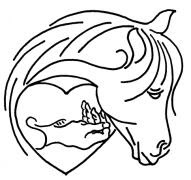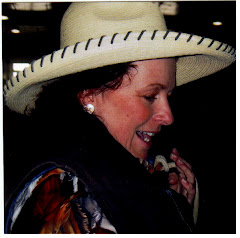Question: I have never been to a clinic or taken formal lessons. What kind of things can one expect to learn when taking lessons or going to a natural horsemanship clinic or camp? How will I benefit?
There are Four Categories of Learning which any good instructor or clinician should cover to help their students become excellent horsemen. These categories are best mastered when taught in a progressive order. A good instructor teaches each category beginning with the easiest and most fundamental skills and slowly builds up to the more complicated aspects of training.
These are the four categories which I guide my students through over time.
1) FOCUS & PARTNERSHIP
(Developing the Learning Frame of Mind)
2) FEEL & TIMING
(Groundwork Skills and Fitness) 3) BALANCE & RELAXATION
(Secure Seat and Postural Training for the Rider) 4) CONFIDENCE & COLLECTION
(Perfecting Communication and Movement for the Horse) Level 1 FOCUS & PARTNERSHIP
(Developing the Learning Frame of Mind)
The first thing we often need to focus on is breaking through defensive behavior in the horse and training towards general calmness and focused attention on the rider in a variety of situations. The objective in this beginning stage is to develop calm, attentive leadership skills for the horseman so they have a clear plan and distinct focus. The rider works on awareness of self and the horse's response to his/her emotions, communication and leadership. Any person who is struggling with a horse who has behavioral issues, is new to natural horsemanship, or just needs a refresher course in reading a horse and how to respond to different horsenalities will benefit.
During this phase we focus on the psychological aspect of training. The exercises begin on the ground and will be carried directly up to the saddle. For people with confidence issues, a young horse, challenging horses or a remedial horses this is the place to start a healthy, happy partnership. If your horse has lameness issues or can’t be ridden for one reason or another, this is a great area of learning where you can make surprising progress and begin to have fun with your horse again.Level 2 FEEL & TIMING
(Groundwork Skills and Fitness)
After a person has developed a learning frame of mind, establishes a definite focus and is forming a partnership with their horse we move on to developing three layers of fitness in the horse and rider. The student is presented with challenging exercises which are designed to help them have better emotional, mental, and physical fitness.
1. Emotional Fitness (calm, focused, and attentive during activities),
2. Mental Fitness (understanding movement, energy and skill development)
3. Physical Fitness (timing, position, and self-carriage in movement)
This is where both the horse and rider learn their specific roles in the partnership. Although we often think of groundwork as something for the horse, it is just as important for developing the balance, feel and timing of the rider. Confidence, leadership, and communication are best developed in the context of groundwork because the separation helps clarify issues that are most often the result of miscommunication or misunderstandings between horse and rider.
Equipment is best assessed in this category so the rider can become fully aware how various training equipment, ropes, halters, whips, sticks, saddles, padding and bridles effect communication and motion.Level 3) BALANCE & RELAXATION
(Secure Seat and Postural Training for the Rider) With better feel and timing produced through the ground exercises for emotional, mental and physical fitness we can now begin to focus on the rider's balance and position while on the horse's back. Ideally this begins on the ground using exercise balls and reins for simulation exercises. During the mounted sessions a safe demo horse should be available for the participants to ride. A lesson horse is invaluable when helping a rider learn to have an independent seat. It is easier for a person to do postural training if they are not worried about their safety.
Once in the saddle, this category of training focuses on the rider finding their ownpoint of balance and working from their core on the back of a horse. We focus on the rider's balance through secure seat stretches and exercises so the rider becomes more aware their body. This also helps the rider realize where and how the horse is struggling and then they can offer better assistance to the movement of the horse.
With better focus, feel, timing, and balance the rider is now able to provide clear communication which is recognizable and useful to the horse. I have noticed as a student develops a more secure seat through proper placed legs and correct posture their whole body is stabilized and then their hands become softer, quieter and firmer when needed. Softer, quieter, dependable hands produce a more confident and willing horse who moves with fluidity.
Having a sense of balance which is independent of the horse's motion is whatprofessional riders have that gives them the ability to ride a variety ofhorses very well. While this level of quality is not often taught tonon-professional riders I believe it is imperative for all riders to learnbecause the correct development of a horse depends on good rider posture.Correct posture also helps a rider feel safer. With that feeling of securitycomes the confident, calm leadership from the saddle the horse is lookingfor.
Level 4) CONFIDENCE & COLLECTION
(Perfecting Communication and Movement for the Horse) It is not until the rider has proper balance, posture, and relaxation that they can attain a secure seat. When a consistent secure seat is natural for the rider we can finally turn our focus to the horse and helping him achieve better balance and athleticism while carrying a rider. It is a learned skill for a horse to be able to find the correct use of his body while bearing the weight of a rider. Although a horse can and often "do" what is asked while he is unbalanced, the cumulative effect of riding an unbalanced horse is lameness, illness or behavioral problems.
Understanding the difference between quality movement and acceptable movement helps the rider understand WHY the horse has poor performance, behavior problems, or chronic health issues. It is a simple matter of basic physics at work between the rider's body, the horse's body and gravity. By helping the horse achieve quality movement under saddle we prove to the horse that his need for safety and comfort while we ride is as important as our own agenda of pleasure or performance.
The fundamental skill of self-carriage is crucial for the health and wellbeing of a horse whether it is only ridden on the trails once a week or is expected to compete at high levels. Your horse will benefit just as much as you will at this level because he will be able to move with more grace which means he will be able to carrying you more efficiently. This produces a more comfortable and enjoyable ride for both you.
If you have any questions about the 4 Categories of Learning or would like to find out more about Horsemanship Lessons, Clinics or Camps presented by Sherry Jarvis Instructor for Heart in Your Hand Horsemanship go to www.heartinyourhand.com or call 308-730-2150. We have personal customer service and a number of different programs so we can be there for you during the challenges and guide you toward success on your horsemanship journey.
Saturday, August 9, 2008
Subscribe to:
Post Comments (Atom)













No comments:
Post a Comment